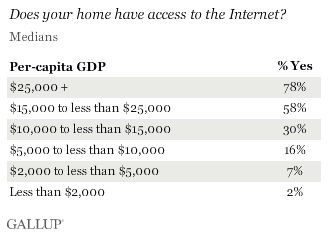WASHINGTON, D.C. -- Among 116 countries and areas Gallup surveyed last year, a median proportion of 2 in 10 adults reported that they have Internet access at home, but the proportion was greater than 3 in 4 adults in 15 countries. These populations in the most connected countries span several global regions, including Europe, Asia, Northern America, and the Middle East.

The most obvious characteristic of all of these countries is that they are developed; none has an annual per-capita GDP lower than $28,000. In countries with per-capita GDPs of at least $25,000, a median of 78% report being online at home. Greece is the only country in this group where less than half of residents (39%) report home Internet access.
As countries' income levels drop, so does residents' Internet access at home -- most precipitously among countries with per-capita GDPs of less than $10,000.

Populations in the most connected countries also tend to be highly urbanized, reducing the cost of extending Internet delivery modes -- whether phone and cable lines or wireless towers -- to a high proportion of residents. Two of the most connected populations in the world -- residents of Singapore and Hong Kong -- are entirely urban.
Implications
Internet access is clearly a function of economic development; as recent trends in China demonstrate, demand for electronics and online services grows as living standards rise along with disposable income levels. Lack of access, however, also means people are missing chances to connect, including opportunities for entrepreneurs to reach broader markets for their products or for community leaders to promote civic engagement.
In many countries where home Internet access is less widespread, communal access is common; Internet cafes have proliferated, or online community centers are available. Public access points help mitigate some effects of the digital divide -- though as these data demonstrate, the prevalence of home Internet access is strongly associated with relative prosperity worldwide.
See home Internet access for all 116 countries and areas on page 2.
Visit Real Clear World's Top 5s feature to learn more about the countries with the highest reported access to the Internet at home.
For complete data sets or custom research from the more than 150 countries Gallup continually surveys, please contact SocialandEconomicAnalysis@gallup.com or call 202.715.3030.
Survey Methods
Results are based on telephone and face-to-face interviews with approximately 1,000 adults, aged 15 and older, conducted in 2009 in 116 countries. For results based on the total sample of national adults, one can say with 95% confidence that the maximum margin of sampling error ranged from a low of ±2.1 percentage points in China to a high of ±5.5 percentage points in Ireland. The margin of error reflects the influence of data weighting. In addition to sampling error, question wording and practical difficulties in conducting surveys can introduce error or bias into the findings of public opinion polls.


